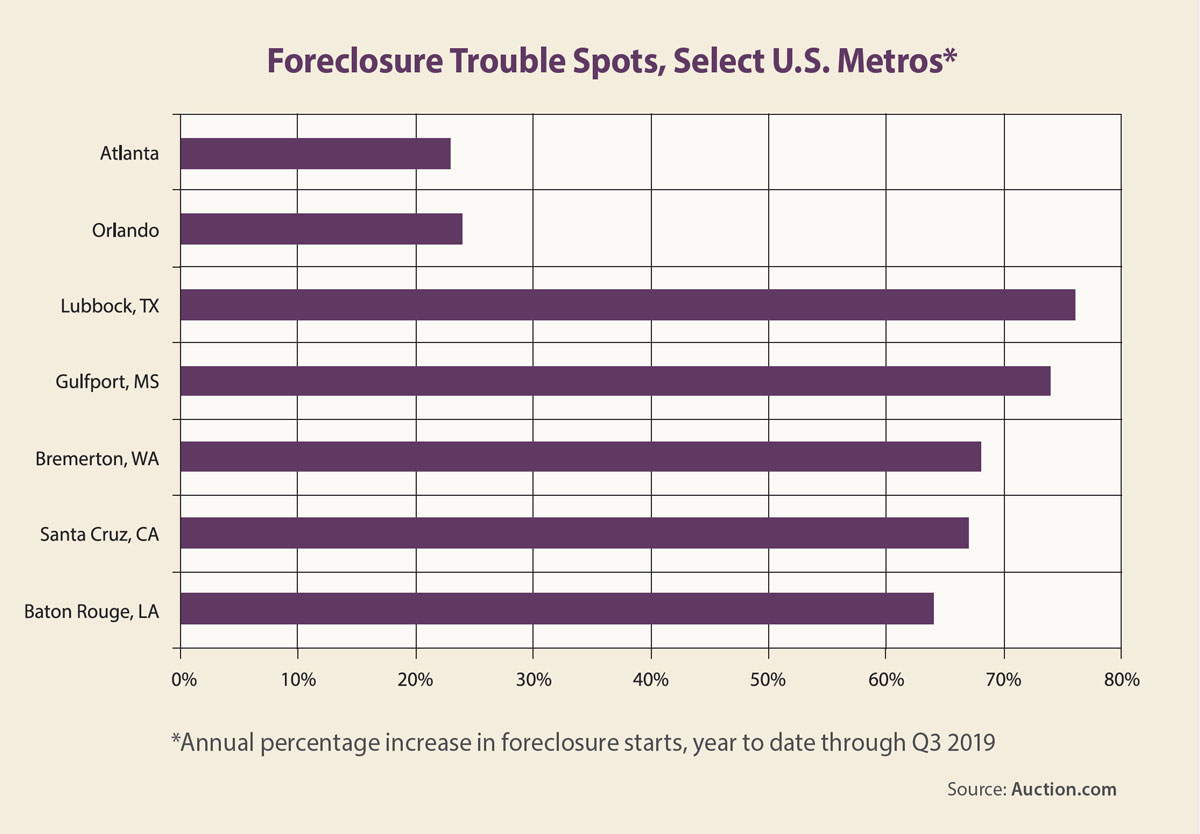Most of the backlog of high-risk loans from the past housing crisis has cleared out of the foreclosure-home pipeline. Auction.com’s research and analysis group has examined key forward-looking indicators of distress in public-records data, as well as its own proprietary-platform data, that will provide insight into the local markets that are most at risk for an expansion of distressed-housing inventory next year.
At the top of the funnel for these leading indicators are foreclosure starts. At the national level, these have seen accelerated declines since a brief uptick in late 2018 and early 2019. Across the U.S., 255,409 residential properties started the foreclosure process in the first nine months of this year, down 10% from the same period in 2018 according to an Auction.com analysis of Attom Data Solutions’ third-quarter 2019 foreclosure-market report.
This trend was reversed, however, in 14 states and 80 of 217 (37%) major metropolitan statistical areas analyzed. States posting a year-over-year increase in foreclosure starts during the first nine months of this year included Florida (up 2%), Georgia (26%), Alabama (3%), Louisiana (18%) and Washington (13%).
The narrative becomes more nuanced when looking at the metro-level data. Year-to-date through this past September, the largest metro areas that posted foreclosure-start increases included Atlanta (up 23%), Orlando (24%), Jacksonville (7%), San Antonio (8%), Seattle (7%) and Denver (3%). Some of the largest percentage increases in foreclosure starts during the same time frame were in Lubbock, Texas (up 76%); Gulfport, Mississippi (74%); Bremerton, Washington (68%); Santa Cruz, California (67%); and Baton Rouge, Louisiana (64%).
The increases in parts of Florida, Texas and Louisiana may not be much of a surprise given the devastating natural disasters these areas have experienced in the past few years. The upswings in markets such as San Antonio, Seattle, Denver and Santa Cruz are more surprising given that these areas have been poster children for the housing and economic recovery of the past decade.
Proprietary foreclosure-inflow data from Auction.com — which accounts for nearly 50% of the completed foreclosure auctions nationwide — backs up at least some of these surprises regarding increased distress. There were 43,232 U.S. residential properties referred to Auction.com in third-quarter 2019 for a potential future foreclosure auction, up 3% annually.
Historically, 52% of foreclosure-auction inflow eventually makes it to the auction stage, with 96% of these homes brought to auction within six months of being received. The inflow jump in the third quarter of this year indicates there will be an increase in completed foreclosure auctions during fourth-quarter 2019 and first-quarter 2020. The Auction.com data shows 23 states with a year-over-year increase in foreclosure-auction inflow in third-quarter 2019, including Florida (up 57%), New York (45%), Virginia (36%), California (30%) and Arizona (28%).
Among the 363 counties analyzed for auction-inflow data, 215 (or 59%) posted an annual increase in the past third quarter. These include Maricopa County, Arizona (up 34%); Miami-Dade County, Florida (52%); Los Angeles County, California (30%); and Bexar County, Texas (up 16%). Interestingly, all three counties in the Seattle metro area (King, Pierce and Snohomish) posted year-over-year increases, as did three counties in the Denver metro area (Denver, Arapahoe and Adams).
These trends point to an emerging third wave in the distressed-property market following the Great Recession. The first and largest wave involved the logjam of high-risk mortgages left over from the housing crisis. The second wave was smaller and more localized, triggered by a series of natural disasters beginning around 2016.
This third wave is occurring in many markets that have experienced rapid home-price appreciation and strong sales activity over the past seven years. The most obvious crack in the armor of these markets is affordability — specifically, lack of affordable-housing inventory for many prospective homebuyers. This may be the Achilles’ heel driving increased levels of distress in these previously insulated markets.
Author
-

Daren Blomquist is vice president of market economics at Auction.com. In this role, Blomquist analyzes and forecasts complex macroeconomic and microeconomic data trends to provide value to both buyers and sellers using the platform. Blomquist has been cited by thousands of media outlets nationwide, including major news networks, The Wall Street Journal, The New York Times and USA Today. Prior to Auction.com, Blomquist worked at Attom Data Solutions.




